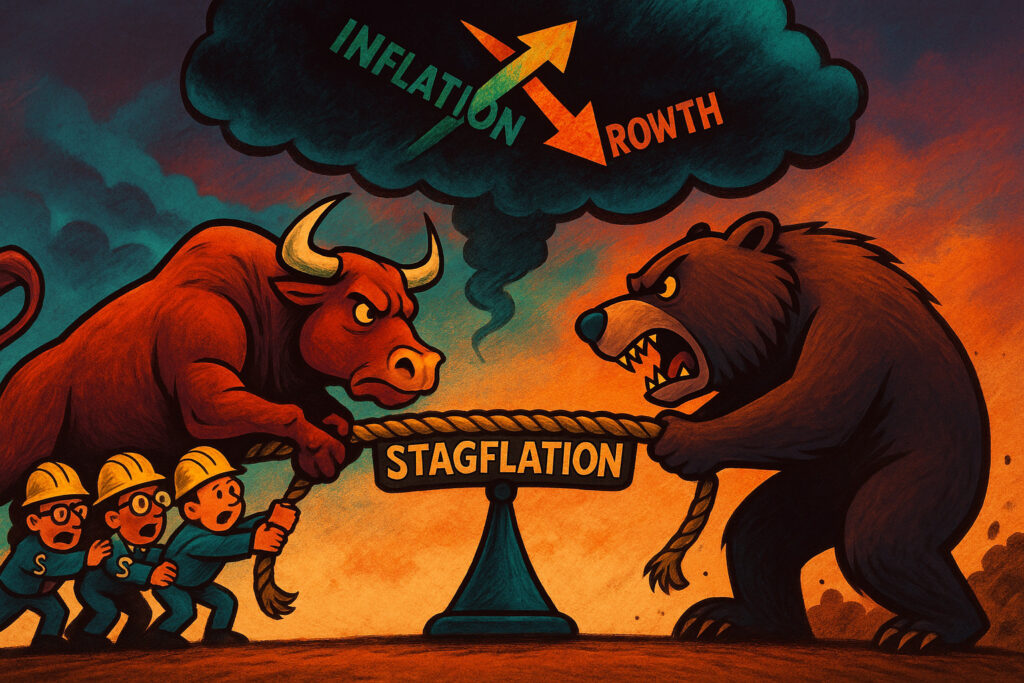Introduction
On 17 August 2025, global financial markets moved cautiously higher amid growing tension between inflation fears and fading growth signals. While markets appeared buoyant, the specter of stagflation—sluggish growth combined with sustained inflation—loomed larger. Surveys indicated that a majority of institutional investors now expect U.S. stagflation within the next twelve months, a grim possibility that has the potential to disrupt long-term portfolios.
Despite these concerns, equity indices, particularly across cyclical sectors, held firm. Small-cap stocks advanced notably, suggesting renewed confidence in lower-rate expectations as investors eyed the Federal Reserve’s upcoming signals. Commodities, currencies, and safe-haven assets like gold reflected a defensive tone, while bond markets largely held steady, balancing inflation concerns with moderating growth. The tug-of-war between growth optimism and inflation anxiety encapsulated the day’s defining market narrative.
Equity Markets Show Cautious Optimism
Equity performance on the 17th was mixed but characterised by resilience. Small-cap equities outperformed broader indexes, buoyed by expectations of an imminent rate cut. Institutional investors, especially following commentary from Oppenheimer, began repositioning toward risk assets in anticipation of looser monetary policy. This optimism extended into the S&P 500 and Nasdaq, both of which sustained record highs despite underlying uncertainty.
The rally in small-caps was particularly visible and reinforced the notion that confidence in future earnings and rate relief remains intact. However, market breadth was uneven; while cyclical sectors like industrials and financials gained ground, defensive areas held their own, underscoring an underlying cautiousness.
Stagflation Risks Gain Ground in Investor Sentiment
Investor sentiment shifted noticeably toward inflation-driven pessimism. A survey by a leading global research firm revealed that approximately 70 percent of investors anticipate stagflation in the U.S. within the year ahead. This elevated concern stems from recent data showing a weakening labor market, persistent core inflation, and rising producer prices.
The implications are profound. Long-duration bonds, exposed to the erosive effects of inflation, appear increasingly vulnerable to sell-offs. Investors are positioning accordingly, with inflation-linked assets and gold drawing renewed interest. Despite this caution, equity prices remain elevated—suggesting markets may be discounting stagflation rather than pricing it in directly.
Bonds Reflect Inflation Versus Growth Tension
Bond markets conveyed a dual message. Long-term Treasury yields remain pressured by inflation expectations, while short-term yields, more sensitive to rate cuts, exhibit some compression. The continued inversion of the yield curve remains a warning signal for growth prospects, though its magnitude has slightly eased—something some interpret as prudent hedging rather than outright alarm.
Investors are increasingly using inflation-protected bonds, such as TIPS and inflation swaps, to shield portfolios amid growing stagflation anxiety. These positions suggest that while risk appetite endures, protection from inflation is becoming a growing priority.
Commodities and Safe Havens Respond Defensively
Commodity markets responded to stagflation fears with defensive positioning. Gold, the traditional inflation hedge, gained traction as investors sought protection from both inflation and policy uncertainty. Meanwhile, oil prices remained subdued—dampened by concerns about global demand, especially from China, and potential diplomatic shifts that could affect energy markets.
At the same time, industrial metals like copper held steady but lacked bullish momentum. The mixed performance across commodities underscores a market mindset balancing growth expectations with caution about deteriorating global demand.
Emerging Markets and Currency Trends Diverge
Currency markets mirrored the bifurcated sentiment. The U.S. dollar showed relative weakness, pressured by fears that stagflation and eroding purchasing power may undermine its strength. The euro and other major currencies, which have appreciated strongly against the dollar year-to-date, continued to benefit from this trend.
Emerging market currencies offered a split picture—some, like the Indian rupee, remained resilient amid inflows into equities, while others, particularly in Latin America, weakened amid softening commodity demand and slower growth outlooks.
Investor Positioning: Hedging Amid Uncertainty
Investor positioning reflected a balancing act. On paper, equity markets maintained strength, especially in the cyclicals. In practice, many institutional investors increased exposure to inflation-resistant instruments and sought derivative strategies to hedge against downside risk.
Cautious optimism prevailed: while investors remained engaged with equities, portfolios were increasingly safeguarded with volatility hedges, capped-interest products, and defensive sector allocations. Sentiment indicators hint at fragility, with complacency risk rising as volatility metrics remain low.
Conclusion
The trading session on 17 August 2025 encapsulated the current subtle tension in global markets. Equity markets, led by small caps, continued to show resiliency and investor readiness to lean in on rate-cut expectations. Meanwhile, the darkening prognosis of stagflation prompted defensive moves—especially toward inflation-linked bonds, gold, and hedging strategies.
Looking ahead, the key driver will be how future macro data and central bank communications shape investor intentions. Key questions loom: Will the Federal Reserve validate hopes for a rate cut, or will inflation remain stubbornly high, ultimately undermining growth? How severely might stagflation, if realized, unsettle market valuations and bond dynamics?
For now, markets are balancing bullish undercurrents and elevated caution—a poised optimism tinged by hedging instincts. This delicate equilibrium may define the path forward for investors until more definitive economic signals emerge.
